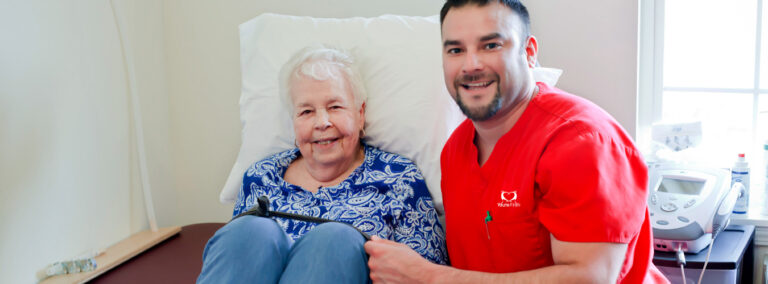One out of three seniors will fall this year, but fewer than half of them will talk with their doctors about it, according to the Centers for Disease Control and Prevention. Falls are also the No. 1 cause of injuries in seniors, resulting in fractures, cuts, and even serious head and brain injuries that can be fatal. And even when there’s no serious injury, a fall can still be so frightening that seniors may avoid certain activities because they’re afraid they’ll fall again.
More than 80% of older adults have at least one health condition like diabetes, stroke, arthritis, incontinence, or dementia. Often these conditions increase the risk of falling because they result in lost bodily functions, people rushing, inactivity, depression, pain, or taking multiple medications.
Lack of physical activity is one of the leading causes of falls. Activity is one of the most important ways to reduce your chances of falling. It makes you stronger and improves your balance and coordination.
Whether it’s balance/gait problems, slippery floors, changes in floor surface from one room to another, health conditions, or electrical cords, some of the most common causes of falls are in the home, where you might have a false sense of security. That’s why fall prevention starts with creating a safe living space.
This doesn’t have to involve a complete house remodel or a complete lifestyle change. You can make your home safe from falls with just a few basic changes. Senior care experts offer the following advice for preventing falls at home:
1. Clean up clutter. The easiest method for preventing falls is to keep your home neat and tidy. Remove all clutter, such as stacks of old newspapers and magazines, especially from hallways and staircases.
2. Repair or remove tripping hazards. Sometimes home fixtures can contribute to falls, which can then lead to back pain and other injuries. Examine every room and hallway, looking for items such as loose carpet, slippery throw rugs, or wood floorboards that stick up. Then repair, remove, or replace those items for more effective fall prevention.
3. Install grab bars and handrails. These safety devices are crucial for going up and down stairs, getting on and off the toilet, and stepping in and out of the bathtub/shower without injuring yourself. Gary Kaplan, DO, founder and medical director of the Kaplan Center for Integrative Medicine in McLean, Virginia, suggests installing grab bars next to toilets, bathtubs, and handrails in stairways and hallways. Have a handyman or family member help with this if necessary.
4. Manage your medications. Have your health care provider or pharmacist review your medications, some medications (even over-the-counter medications like cold and flu medications) can make you drowsy or light-headed, which can lead to a fall.
5. Make needed items easy to access. Keep items used often in cabinets easy to reach and avoid using a step stool. Locate the telephone within reach of the bed.
6. Move more carefully. Dr. Bunning explains that many people fall at home by moving too quickly from a sitting to a standing position and vice versa, or blood pressure or blood sugar can drop suddenly, causing dizziness or lightheadedness. Preventing falls like this is as easy as taking your time. “All you have to do is pause and breath after going from lying down to sitting and from sitting to standing,” he says. “Also, take a pause before using the railing on stairs, whether going up or down.”
7. Light it right. Inadequate lighting is another major hazard. To create a home that’s more suitable for the elderly, install brighter light bulbs where needed, particularly in stairways and narrow hallways. Robert Bunning, MD, associate medical director of inpatient services at MedStar National Rehabilitation Hospital in Washington, D.C., also recommends adding night-lights in bedrooms and bathrooms for better guidance at night.
8. Wear sensible shoes. Socks may be comfortable, but they present a slipping risk. Preventing falls at home can be as simple as wearing shoes. You can also purchase non-slip socks that have grips on the soles of the feet if the shoes are too uncomfortable.
9. Make it non-slip. Bathtubs and showers, as well as floors in kitchens, bathrooms, and porches, can become extremely dangerous when wet. To prevent falls on slick surfaces, Dr. Kaplan recommends nonslip mats.
10. Modify movable furniture. Remove casters and wheels from furniture.
11. Have your vision checked. You may be wearing the wrong prescription of glasses or have a condition like macular degeneration, glaucoma or cataracts that limit your vision. Poor vision can increase your chances of falling.
12. Avoid wearing loose clothing. You want to feel comfortable at home, but baggy clothes can sometimes make you more likely to fall. Opt for better-fitting and properly hemmed clothing that doesn’t bunch up or drag on the ground.
13. Live on one level. Even with precautions like handrails, stairs can present a significant falling hazard. “If possible, live on one level,” says Kaplan. “Otherwise be extra-careful when you negotiate stairs.” If it’s not possible to live on one level, try to limit the trips you take up and down the stairs or install stair lifts.
For the elderly, fall prevention means injury prevention. If you or a loved one had a fall or you often feel like you are at risk of falling, don’t just dismiss it as part of getting older, lack of concentration, or clumsiness. Talk to a health professional about different options that may help you.

